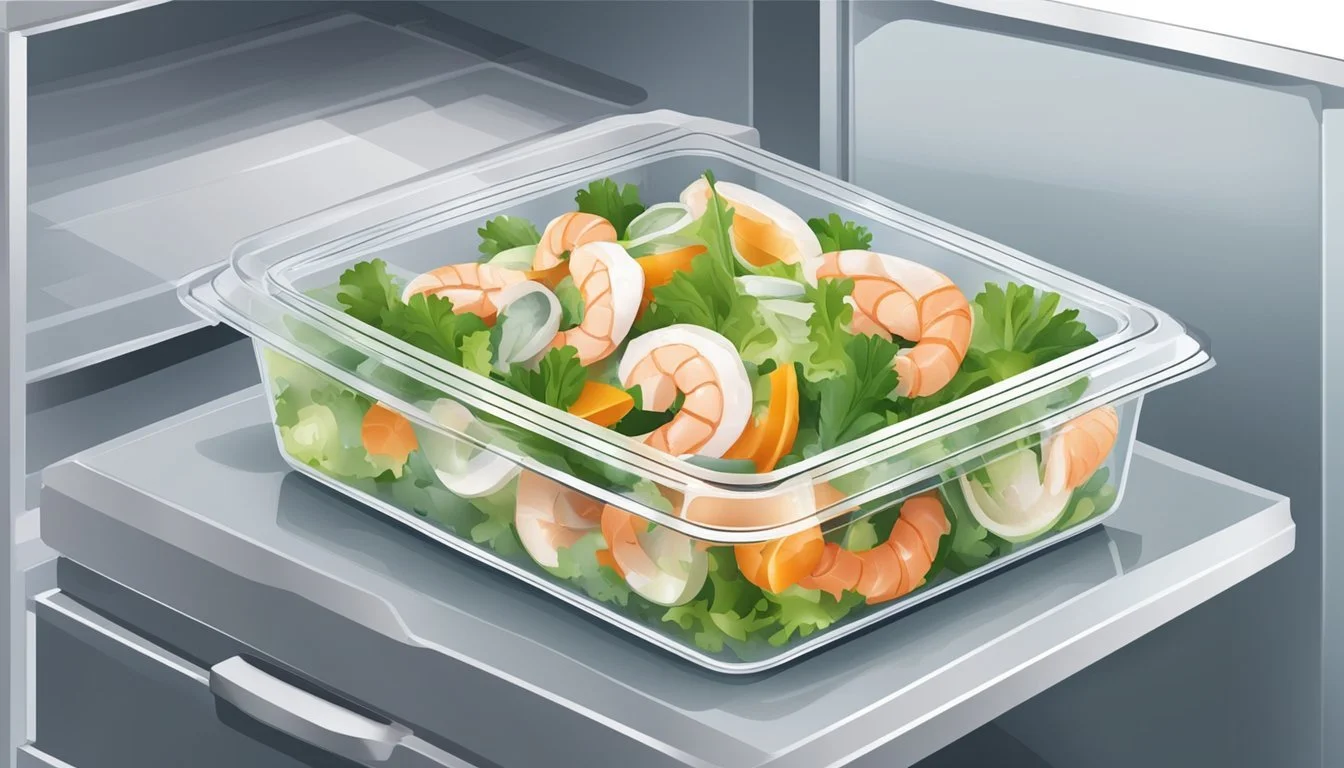How Long Do Seafood Salads Last?
Shelf Life and Storage Tips
Seafood salads are a refreshing and flavorful option for meals, providing a variety of textures and tastes from the ocean's bounty. As with any food containing seafood (What wine goes well with seafood?), the freshness and safety of the salad are of utmost concern due to the perishable nature of its components. Seafood tends to spoil more rapidly than many other proteins, making proper storage and timely consumption essential.
The shelf life of seafood salads (What wine goes well with salads?) can vary depending on several factors, including the types of seafood used, the freshness of ingredients at the time of preparation, and the temperature and conditions under which the salad is stored. Typically, when kept in the refrigerator at a consistent temperature of 40°F (4°C) or below, a seafood salad's optimal freshness is maintained for around 3 to 4 days. During this period, the flavors remain vibrant and the texture of the seafood is preserved.
Storing the salad in an airtight container is crucial to extending its shelf life and ensuring food safety. Exposure to air can accelerate spoilage and increase the risk of bacterial growth, which can lead to foodborne illness. Consumers should always exercise caution and use their judgment when evaluating the salad's condition before consumption, taking into consideration any changes in smell, texture, or taste that might indicate spoilage.
Understanding Seafood Salad Composition
Seafood salad can encompass a variety of ingredients, but it typically features seafood as its primary component. Common seafood choices include shrimp, imitation crab (how long does crab last?) meat, and sometimes tuna, similar to what one would find in a tuna salad. These are often chosen both for flavor and for their ability to be stored in a refrigerated environment for limited periods.
The base of a seafood salad often includes lettuce, lending a crisp texture and freshness to the dish. Celery is also a frequent addition, providing a crunchy contrast to the softer seafood pieces. The combination of these ingredients contributes to the overall taste and texture profile of the salad.
In terms of binders, mayonnaise is a mainstay. It serves not only to hold the ingredients together but also to add a rich, creamy element to the dish. The use of mayonnaise is a common thread with other types of salads like chicken salad, pasta salad, and potato salad, although the proportions and seasonings may differ.
Seafood salads can vary greatly depending on the recipe or the region. Some might incorporate pasta or fruit, shifting the dish toward a pasta salad or a fruit salad in terms of style and substance. Regardless of the variations, proper storage and handling of the seafood elements are crucial due to their perishable nature.
Remembering that each ingredient interacts with each other, both in terms of flavor and shelf life, is important. For instance, acidic dressings could potentially prolong the freshness when compared to a mayonnaise-based dressing, but care must still be taken to consume the salad in a timely manner to ensure safety and quality.
Storage Fundamentals
Proper storage is crucial for extending the shelf life of seafood salad while maintaining its safety and quality. Optimal refrigeration, freezer storage, and the use of airtight containers are essential components for preservation.
Refrigeration Essentials
Seafood salad should be refrigerated promptly after preparation. The refrigerator's temperature should be set below 40°F (4°C) to slow down bacterial growth. It is advisable to consume the salad within:
3 to 4 days if stored in the fridge.
To ensure consistent temperature, store the seafood salad in the coldest part of the refrigerator.
Freezer Storage Guidelines
While freezing is an option for long-term storage, it is not typically recommended for seafood salad due to potential textural changes in the ingredients. If one must freeze:
Wrap seafood salad tightly in plastic wrap or place in a freezer-safe airtight container.
Label with the date of storage to keep track of freshness time frames.
Airtight Containers Usage
Using an airtight container is crucial for maintaining freshness and preventing contamination or absorption of other food odors.
Airtight seal: Best practice is to transfer the seafood salad to an airtight container if it is not already in one.
Plastic bags: Alternatively, sealing in heavy-duty plastic bags can keep out moisture and other contaminants.
Signs of Spoilage
When assessing the freshness of a seafood salad, it is critical to pay attention to its texture, odor, and visual appearance as these factors are strong indicators of spoilage.
Texture Changes
Seafood salad that has undergone texture changes may be unsafe for consumption. The development of a slimy texture is a clear sign of spoilage. Fresh seafood should be firm to the touch and any deviations from this could indicate the seafood is no longer fresh.
Odor Identification
Odors play a significant role in identifying spoiled seafood salad. A foul odor or off smell is indicative of bacterial growth and spoilage. Seafood salads should have a fresh sea breeze scent; if a strong fishy or sour odor is present, it has likely spoiled.
Visual Spoilage Indicators
The presence of discoloration, mold, or any unusual visual changes in a seafood salad are clear visual indicators of spoilage. Mold is often visible in the form of fuzzy spots of various colors and should be considered a definitive sign that the seafood salad is not safe to eat.
Discoloration: Any unexpected color change.
Mold: White, green, black, or other colored patches or fuzz.
Overall appearance: If the seafood salad looks questionable, trust the instincts to discard it.
Shelf Life Details
The shelf life of seafood salad is crucial for both safety and quality. Proper storage and knowledge of the variables that affect freshness can help consumers enjoy their salad confidently within safe time frames.
Shelf Life Variables
Factors influencing the shelf life of seafood salad include the freshness of seafood at the time of preparation, the types of ingredients used, and the temperature at which it's stored. Spices and preservatives, while often enhancing flavor, have a minor effect on seafood salad's freshness compared to these primary factors.
Estimated Shelf Life Durations
Homemade seafood salad: 3-4 days in the fridge
Store-bought seafood salad: Follow the expiration date, typically 2-3 days after opening
Seafood salad in airtight container: up to 5 days, best consumed within 3-4 days for optimal taste
Type Fridge Storage Time Note Homemade seafood salad 3-4 days Best if consumed earlier Store-bought (after opening) 2-3 days Expiration date is crucial for safety In an airtight container up to 5 days Consume within 3-4 days for best taste
Extending Freshness
To extend a seafood salad's freshness:
Store promptly in the fridge at 40°F (4°C) or lower.
Use airtight containers to mitigate exposure to air.
Consume early within the estimated shelf life duration for the best quality.
Food Safety Considerations
When it comes to seafood salads, maintaining food safety is critical to prevent foodborne illness and ensure the product remains safe to consume. Key practices include proper storage, recognizing spoilage, and understanding the conditions that enable bacterial growth.
Preventing Food Poisoning
Proper Storage: Seafood salads should be refrigerated at 40°F (4°C) or below immediately after preparation. They should be placed in airtight containers to maintain freshness and prevent contamination.
Temperature Control: Keep seafood salads out of the "Danger Zone" (40-140°F), where bacteria can rapidly multiply.
Cross-Contamination: Avoid using the same utensils or plates for both raw and cooked seafood to prevent the spread of bacteria.
Detecting Perishability Factors
Visual and Olfactory Indicators: Consumers should check for any changes in color, texture, and smell. Perishable foods like seafood salads may develop a sour or ammonia-like odor, signaling that they are no longer safe to eat.
Texture Changes: A slimy or sticky surface on any seafood component can indicate spoilage.
Expiration Dates: Adhering to recommended use-by dates is a reliable method to assess food safety.
Understanding Bacterial Risks
Harmful Bacteria: Foods that are perishable can host harmful bacteria such as Salmonella or Listeria if not handled correctly.
Risk Minimization: To mitigate the risks, one must always wash hands thoroughly before preparing or consuming seafood salads and sanitize all kitchenware and surfaces.
FDA Guidelines
Time Limitations: According to the FDA, seafood salads should not be kept in the refrigerator for more than two days due to the high risk of bacterial growth.
Advisories: The FDA issues guidelines on the safe handling and storage of perishable foods, indicating standards for various food categories including seafood.
Best Practices in Seafood Salad Preparation
To ensure the most flavorful and safe consumption, certain preparation methods and ingredient selection are pivotal. The optimal preparation enhances taste and offers the best flavor, whilst selecting the highest quality ingredients contributes to a healthy, homemade salad.
Optimal Preparation Methods
Prep: Begin by ensuring all seafood is fresh or properly thawed if previously frozen. Seafood should be cooked just until done—overcooking leads to a rubbery texture.
Serve: It is best to dress the salad just before serving to maintain texture and prevent ingredients from becoming soggy.
Type: Tailor the type of dressing to complement the specific seafood used, considering its flavor profile.
Recipe: Stick to tried-and-true recipes for consistent results or make adjustments to suit personal taste preferences.
Ingredient Selection
Flavor: Choose ingredients that enhance and complement the natural flavors of the seafood. Fresh dill, lemon juice, and a hint of Old Bay Seasoning can elevate the overall taste.
Best Flavor: For the best flavor, source fresh and quality seafood, opting for organic produce where possible.
Dressing: Create dressings that balance acidity and richness. A mix of mayonnaise, lemon juice, and spices often works well.
Healthy: Opt for low-fat mayonnaise or yogurt-based dressings for a healthier alternative without compromising taste.
Handling Leftovers
When dealing with leftovers, particularly seafood salad, it is essential to manage both storage and disposal correctly to ensure safety and quality.
Reusing Seafood Salad
Seafood salad should be stored in the refrigerator within 2 hours of preparation to minimize bacterial growth. It is best used within 2 to 3 days to ensure optimal taste and freshness. If stored in an airtight container, the salad may remain edible for up to 5 days, but it's prudent to assess the salad's condition before consumption. In assessing whether a seafood salad leftover can be reused, one should check for any off odors, unusual textures, or discoloration.
Discarding Unsuitable Leftovers
Leftovers that have surpassed the recommended 3 to 4-day storage in the fridge should be discarded to prevent foodborne illnesses. If any signs of spoilage are evident before this time, such as an off smell or the presence of mold, they should also be thrown away immediately. Keep in mind the following guidelines when discarding leftovers:
Do not taste the seafood salad to determine its safety.
Seal the leftover seafood salad in a disposable container or bag before discarding to prevent contamination.
Adhering to these practices ensures that one can enjoy seafood salad leftovers safely and avoid potential health risks.
Temperature's Impact on Freshness
Temperature control is crucial in maintaining the freshness of seafood salad. The rate of bacterial growth, which affects both safety and quality, is highly temperature-dependent.
Safe Temperature Ranges
Seafood salads should be stored at a temperature of 32°F to 40°F (0°C to 4.4°C); this is the range in which refrigerators should operate to effectively suppress bacterial growth. Using ice or ice packs can help maintain seafood salads at a safe temperature during transport or when a refrigerator is not available. It's critical to never leave seafood salad at room temperature for more than two hours.
Refrigerator Temperature: 32°F to 40°F (0°C to 4.4°C)
Maximum Time at Room Temperature: 2 hours
Temperature Fluctuations
Avoid frequent temperature changes, as they can compromise the freshness of seafood salad by allowing bacteria to multiply rapidly. Seafood salad should not be left out on the counter during meal prep for extended periods. When thawing frozen seafood for salads, it should ideally be done in the refrigerator, not at room temperature.
Thawing: In refrigerator, not at room temperature
Avoid: Leaving seafood salad out on counter during preparation
Special Cases in Seafood Salad Storage
Storing seafood salad requires consideration of specific ingredients and portion sizes, which affect its freshness and safety. Paying attention to dairy components, storage quantity, and freezing protocols ensures optimal quality.
Seafood Salad with Dairy-Based Ingredients
Seafood salads that incorporate dairy-based ingredients such as mayonnaise, yogurt, or cream-based dressings are prone to quicker spoilage due to fats and protein content. These components can separate or become rancid, shortening shelf life. Salads with dairy should be consumed sooner, typically within 2 days, and maintained at a consistent refrigeration temperature to prevent the growth of bacteria.
Storing Seafood Salad in Small Quantities
When storing small quantities of seafood salad, one should ensure the salad is in an airtight container to minimize exposure to air, which can dry out the salad or introduce contaminants. Smaller portions often warm up quicker, so it's essential to return them to the fridge immediately after serving.
Freezing and Thawing Considerations
While it's not generally recommended to freeze seafood salad, especially if it contains ingredients that may become watery or change texture upon thawing, there may be scenarios where freezing is necessary. If one must freeze the salad, consider:
Freezing in small, flattened portions for even thawing.
Thawing in the refrigerator rather than at room temperature to reduce the risk of bacterial growth.
Dairy, sugar, pepper, and other seasonings in the salad will also behave differently when frozen and thawed, possibly leading to a less desirable texture and flavor when consumed.








